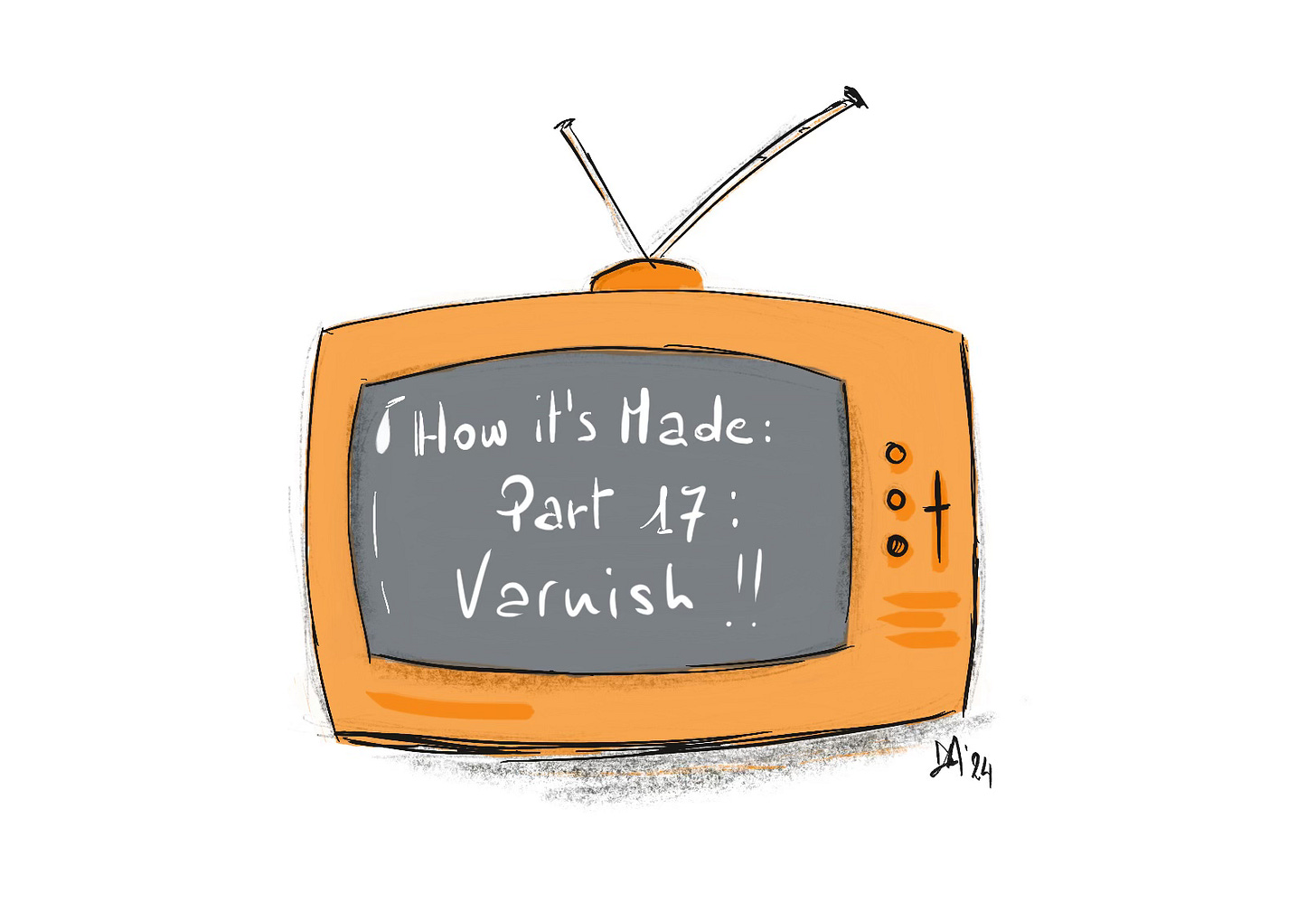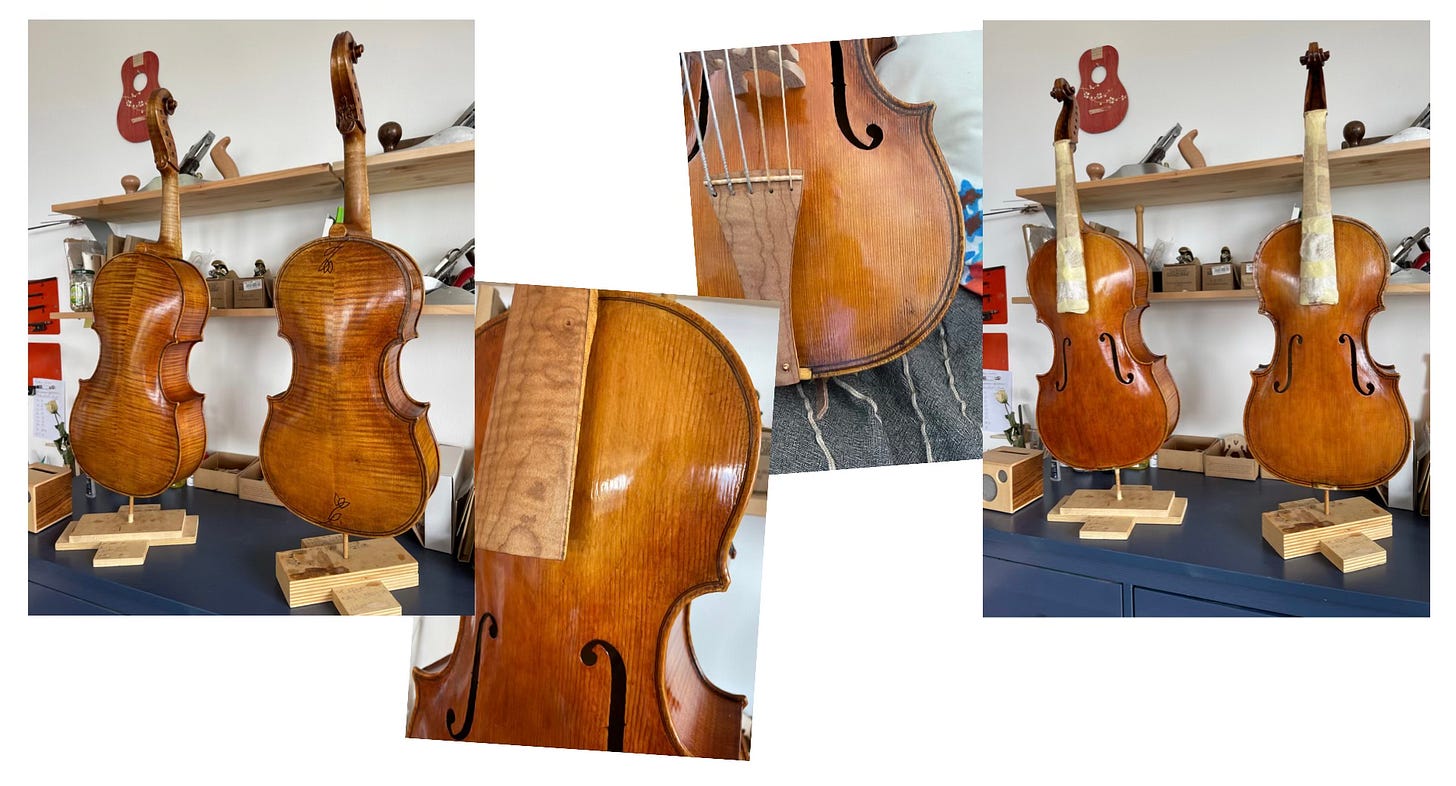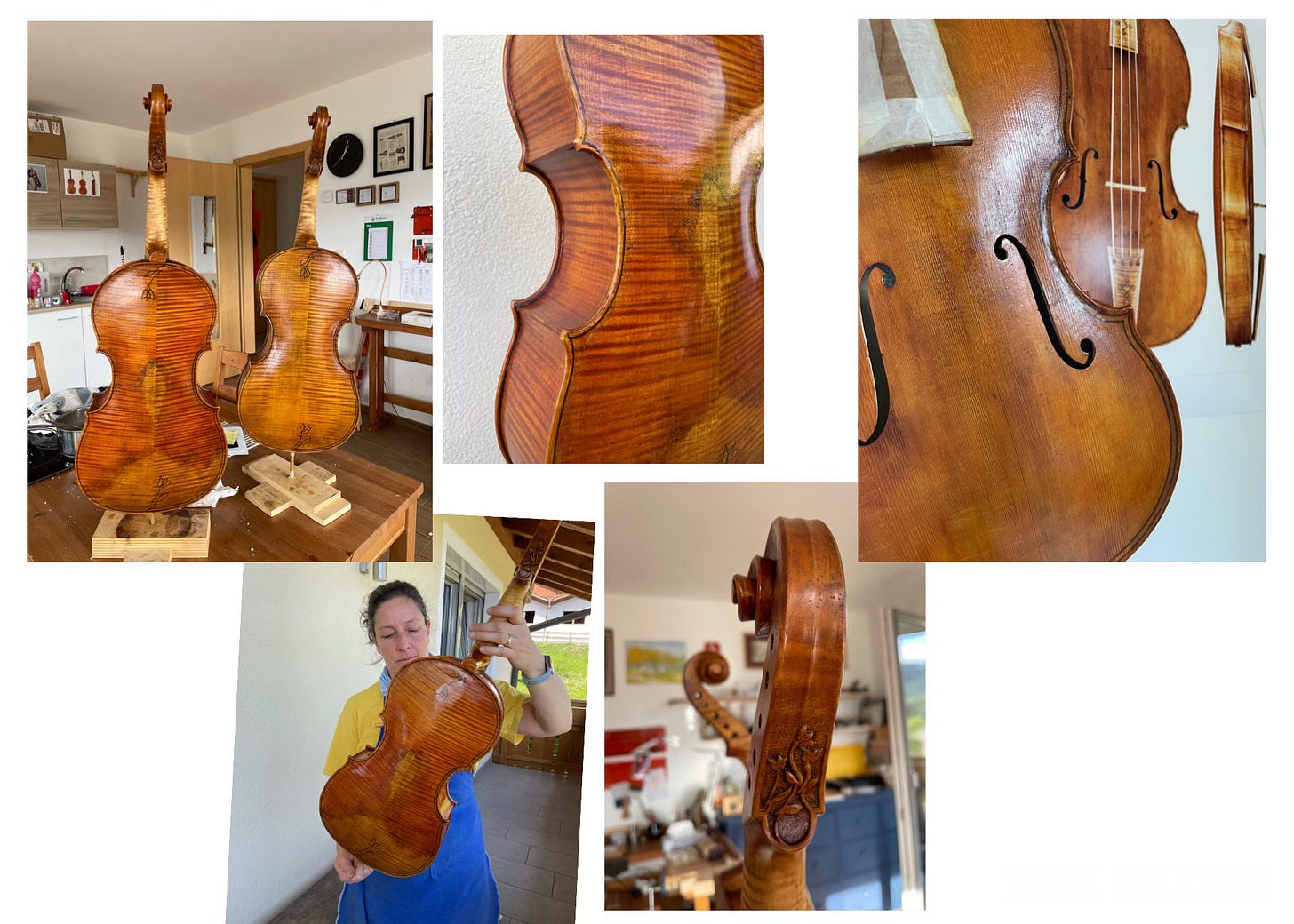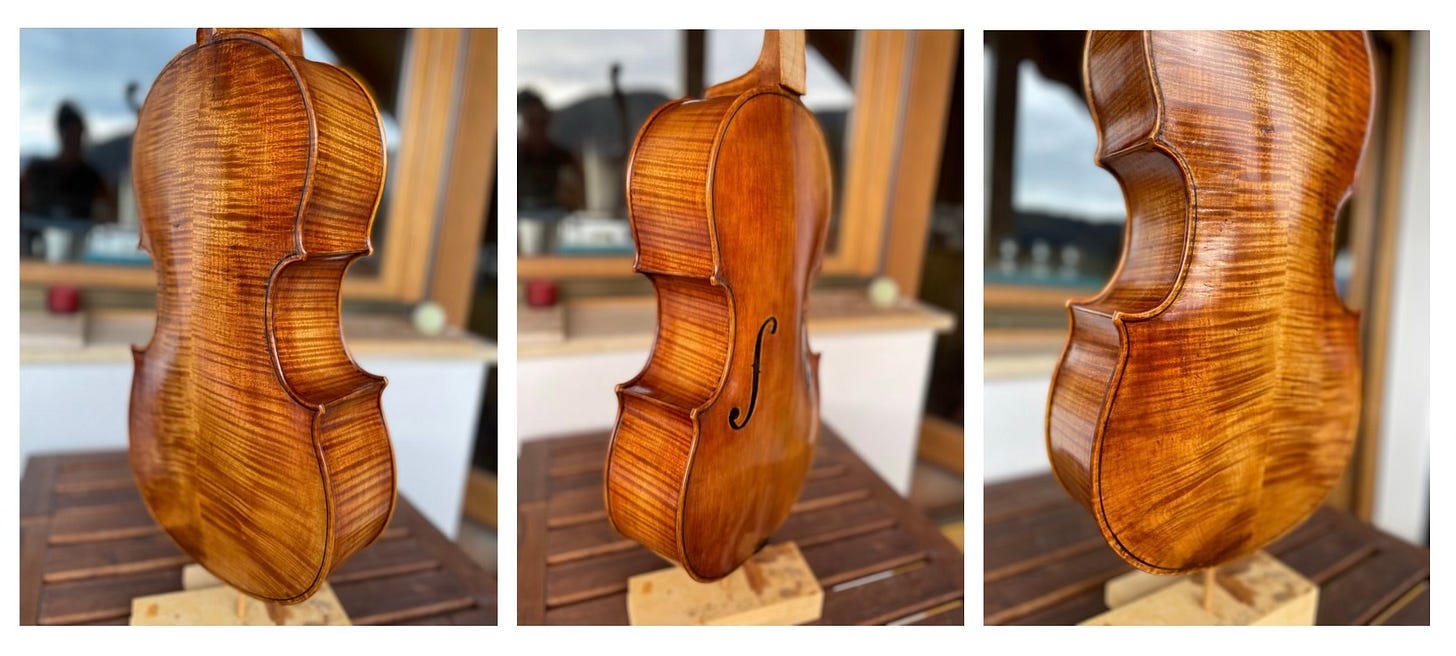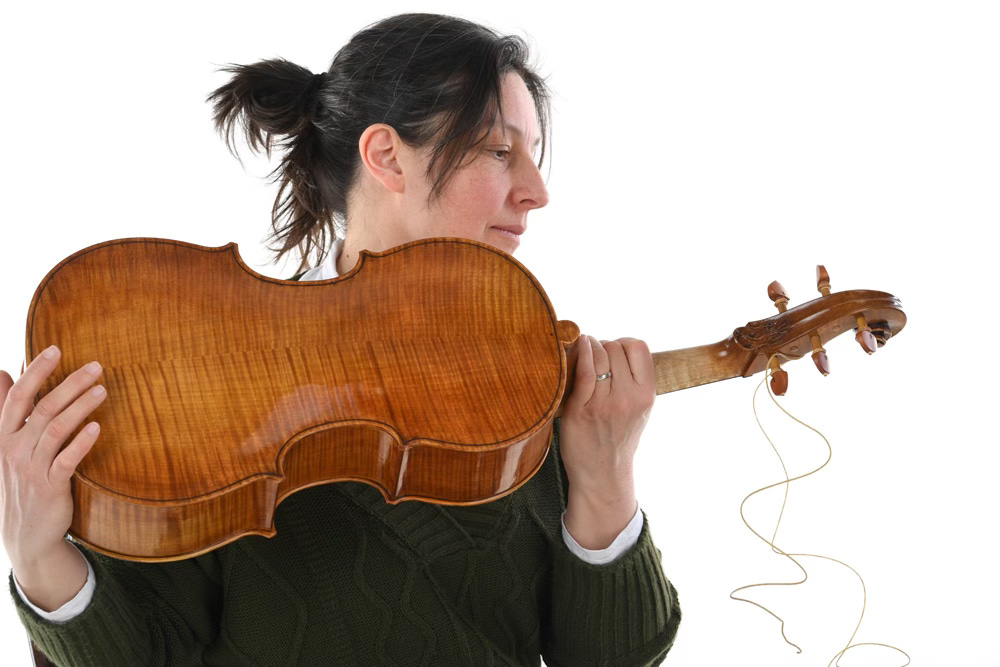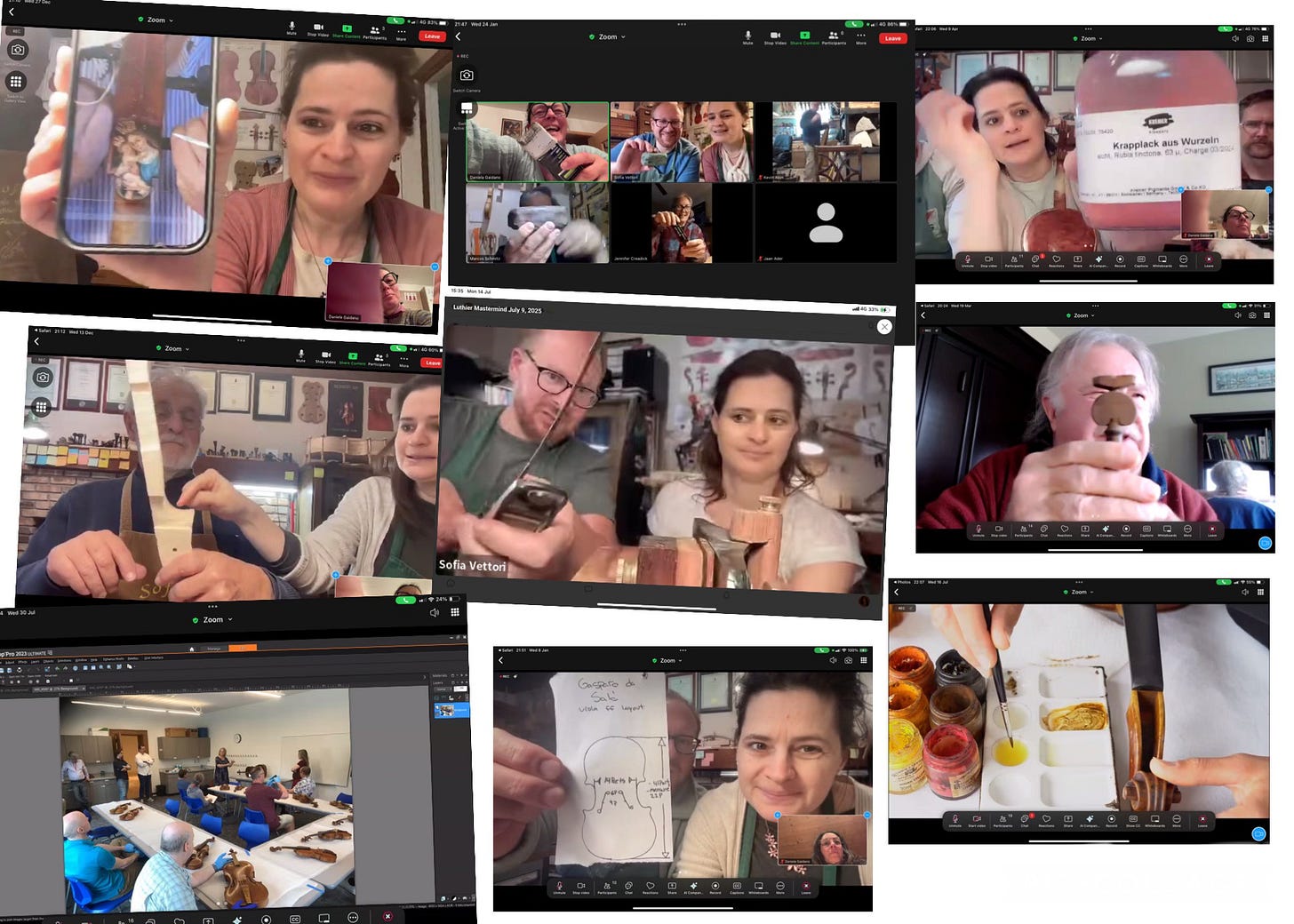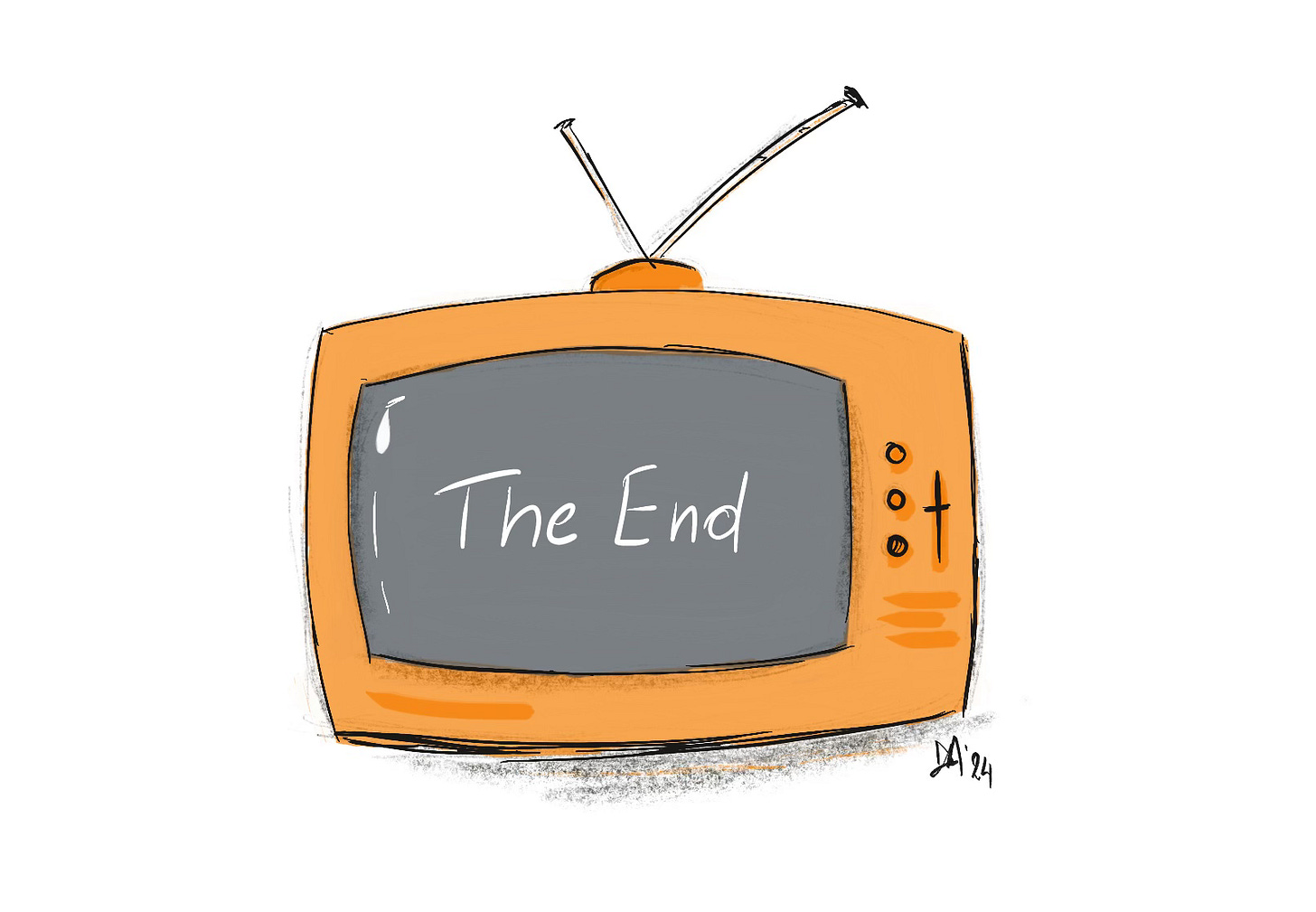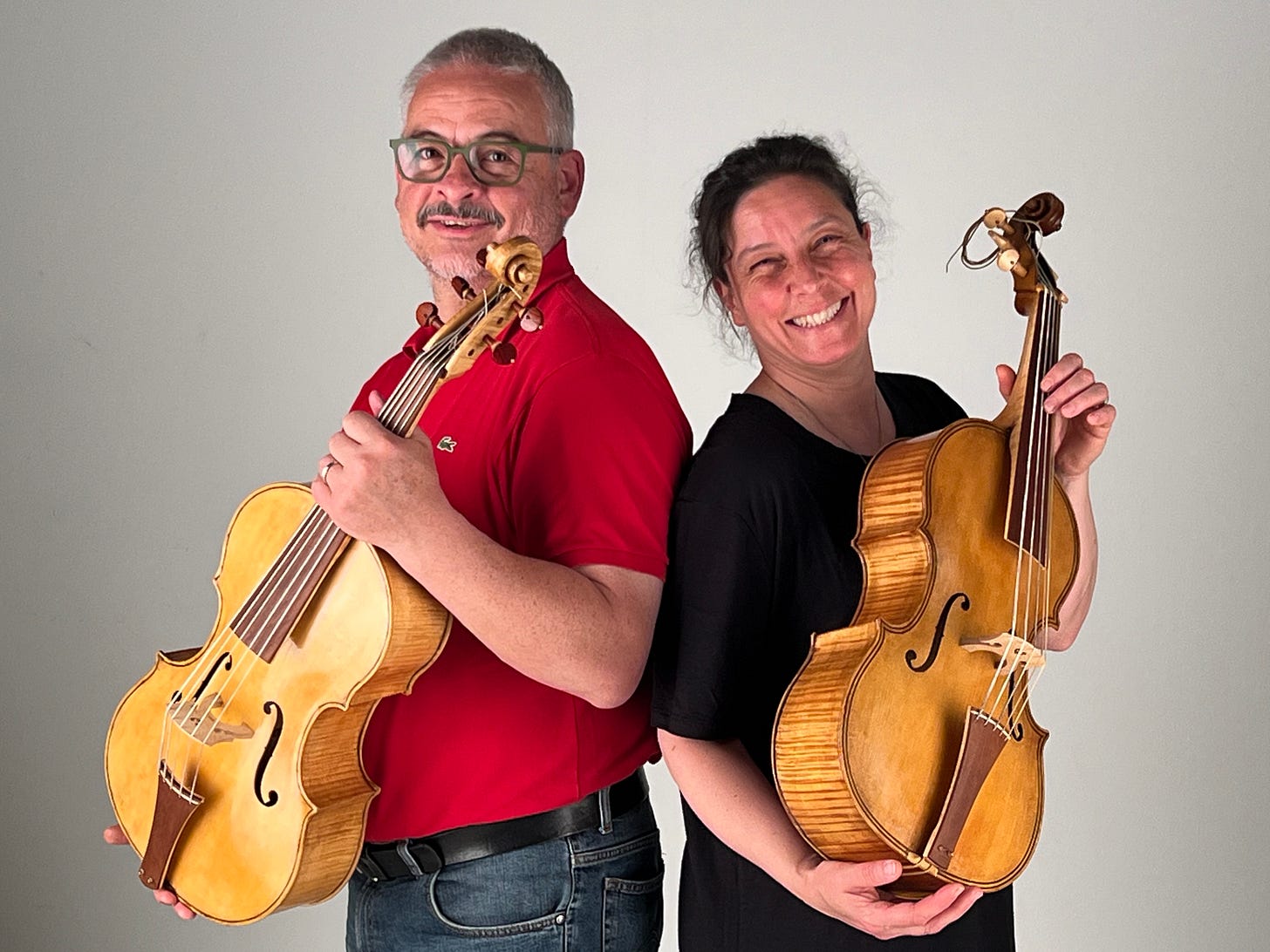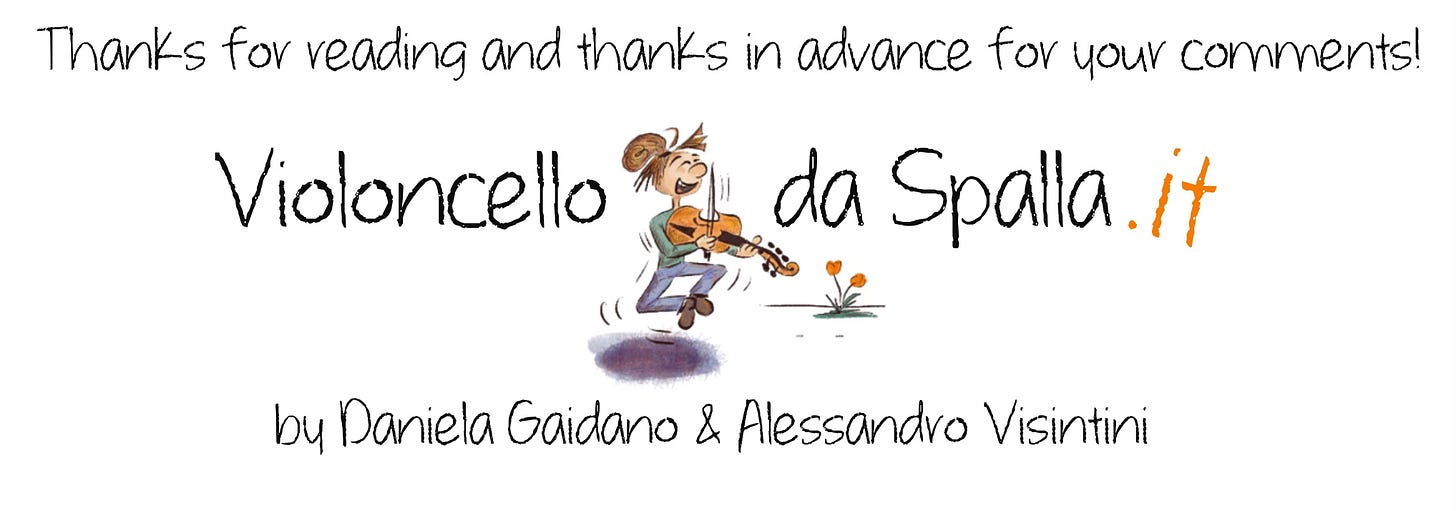Varnishing is such a fascinating process, and it is also very personal.
I like to experiment and “go with the wood”. I don’t plan in detail for the look or colour of an instrument, and I see day by day what the wood (or my mood) suggests to me. During the making, when the instrument is not made on order, I usually start to figure out a character for it. When I make two simultaneously, one is generally modern, and the other is baroque.
There are not many differences in the structure itself, but my thinking about them in two such different ways makes them different in things like the bassbar and fittings. This year, the modern one ended up having real modern fittings: the fingerboard and tailpiece are made in environmentally friendly sonowood-spruce by w-fittings, and the pegs will be Pegheds, luxury and smooth working, perfect for modern strings.
Most of the makers of Violoncello da Spalla make a compromise instrument, a baroque-born instrument that can fit modern strings. Indeed, all da spallas can fit modern as well as baroque strings, but the setup of the strings on the nut and bridge is very delicate, and should be taken care of by a luthier, because of the different gauges of the various sets of strings.
But as I make two at the same time, with two different characters, my baroque instruments are not born as compromise instruments. They can be set up for modern strings, but they have had only gut strings on, and their setup is well cared for with gut strings.
The two characters usually reveal aesthetically as well at the moment of varnish. Last year, the modern one had a single purfling, no special decorations, eye-catching wood, and a brilliant brown-red varnish. The baroque one had less pigment in the varnish, was slightly antiqued, had double purflings, and had my signature carved flower decoration on the back of the pegbox.
This year, I was in the mood for antiquing. It was a brave day, and I wanted to go with the look of those posters I admire and use as references. So for the modern one, I went for a Strad red, heavily worn on the back from the da spalla usage. The small basses were carried around for processions or square dances, usually without a case but hanged to something (hooked at a button of the mantle, as Walther describes in his “Praecepta de musicalishen composition”, Weimar 1708, but most likely just hanged and thrower on the back like a backpack), so they cannot be in pristine conditions as new.
For the baroque one, I went for the big Steiner viola poster from The Strad, which I find incredibly fascinating. It shows the wear of 400 years of usage.
I cannot tell you the varnish recipe or the antiquing methods here, because I learned them from a course that you can buy online.
You can buy Sofia Vettori’s Varnishing course at this link. This is an affiliate link, meaning I will receive some money if you purchase through it.
For the first five who will buy from that link, I will send a physical copy of our Violoncello da Spalla book with our research, all quotes from treatises and all the references you need to talk to your customers about it. If you already have this book, you can receive my other book “Tables on the Evolution of gut strings” instead. The first three will also receive a special da Spalla mug. But the first one, on top of all that, will get a 1 to 1 zoom call with me to ask anything about da spalla making, da spalla sources, gut strings, anything I can help you with!
So if you are interested, don’t postpone it for months, buy it now. If you decide to do so, check that you are clicking on this link when you are ready to buy, and I will contact you to present you with all the above!
When Sofia published her online varnishing course, I was very pleased to expand my palette of possibilities. I had experience with spirit and oil varnish, but was not completely satisfied with either.
Sofia’s video lessons are very detailed. She literally prepares all the materials, cooks the varnish, and varnishes a violin in front of you, with no cuts or editing. She demonstrates many ways of antiquing and always adds videos and techniques.
I love this varnish because it’s as simple to make as all spirit varnish, but thanks to the special recipe, it is as easy to apply as oil varnish. You can paint with it, like you are making a painting; it is very ductile. It could also make varnishing a speedy process: if you are in a hurry, you could get from white to settled in one week.
Another plus is that it doesn’t crack or flake off: I can tell because my own instrument has taken bumps and was worn not only by normal usage but also from testing dozens of strings and being carried around in several different cases, including soft bags. After a bump, this varnish seems to be able to cure itself and retake its original shape. If there is more evident wear, with some varnish consumed, a good polishing will bring it back to its brilliance. It is also very easy to retouch if necessary.
On top of being beautiful, it doesn’t need many coats, so it doesn’t prevent the instrument from vibrating. It’s a perfect varnish: easy to prepare and apply, beautiful, and with good sound! You cannot possibly desire anything better!
Before writing “The End” below this project, I want to share one more “secret” with you. I am grateful to a special group I am part of: the “Mastermind Luthiers Lab” by Sofia Vettori.
The idea behind this group is that sharing our making processes enriches the others without impoverishing ourselves. On the contrary, increasing the general quality level of the industry is an advantage for everyone. For the same reason, I decided to share the making of the Violoncello da Spalla: having more beautiful spallas out there will increase the interest of good musicians and consequently widen the market for everybody. Conversely, when ugly and unplayable instruments are more common and readily available than fine ones, it’s hard to involve good musicians and create an enjoyable environment.
Back to the Mastermind Luthiers’ Lab, I’d like to write about my favourite features, those that kept me there for two years now:
Community chat: There is a chat on the Skool app where we share, ask, and stay connected. It reminds me a bit of a Facebook group, with a feed to scroll, private messaging, categories, and an easy research feature. I love checking it out during my morning coffee and seeing what everybody else is up to. By now, we are about 20 people. It is a safe place, completely free from judgment, where everyone is generous. If I had to describe the attitude in there, the first thing that comes to mind is that everyone is sharing with generosity
Weekly Zoom meetings: every Wednesday we have a Zoom meeting of one hour where we can ask live ur doubts or chat about tools and methods. I must confess that when I decided to join the group, I thought I wouldn’t attend the meetings because Wednesdays and Sundays are our only free evenings to stay together. However, they are so interesting and fun that I rarely miss them. And if I do, the recording will be available in the app in a few days. A few weeks ago, one of the members participated in a special viola workshop week at the National Musical Instruments Museum in Vermillion, South Dakota. He shared his experience, takeaways, and the museum collection’s pics with us!
Special Guests: this is an incredible added value: every couple of months, during the Zoom call, special guests talk about specific topics. They are at the top of their field, and often it’s not easy to access their knowledge elsewhere! Until now we had: Ed Mingo from Pirastro speaking about the history of the company and the characteristic of the various sets, Thomas Croen on special DIY tools for setup, Boris Haugh and Kathy Reilly on alternative materials for fingerboards and fittings, Eric Mayer on pegs and tailpiece, Daniel Gillespie on 3D tech in violin making, Iriss Carr on retouching. The next one will be Pierre Flavetta on grounds and varnishes. And sometimes we also have Paolo Vettori, Sofia’s father, happily sharing his lifelong experience!
Archive: The Skool app is our archive for everything: all the Zoom call recordings, special guests, and chat discussions. You get access to everything from the moment you subscribe. This archive is so valuable and ever-growing!
Violoncello da Spalla instructions: I published there the draft of this project to get feedback from the other members and help on technical terms before publishing here. So, the da spalla project is part of the Mastermind archive too, and as a couple of members will probably make one, there will likely be discussion about it there!
Sharing, getting help, friendship, support, fun… and mental health, because being a luthier can be a lonely journey without a group like this to be in. We can talk about everything except marketing (this is a different project by Sofia). Some participants are professionals with decades of experience, others are amateurs at their beginnings, some are mainly into restorations, others into making, and we are from all over the world. And all of us enjoy a chat on the best rasps around, a look into the other members’ collection of planes, not to mention nerdy DIY tools and gigs. All in all, it is a vibrant and safe environment.
Every month there’s a raffle, and Sofia and her husband Ted give away something precious like a book, a rasp, a plane… everybody can win, also multiple times!
All the members have a 20% discount on buying Sofia’s violin-making courses
Special violin-making project! This is something we’re all very excited about. Starting from late October, we will all make the same violin from the same model, sharing our experience in the chat. We decided to start from the Kreisler Guarneri, and Ted Skreko, Sofia’s husband, will prepare templates and moulds for everybody and send pics and technical info. Kevin, another member, will share images from the CT scans of the violin so that we will have precise information about the archings and other features. This special violin project is not compulsory for the members, and the timing is also not mandatory. Everything will be shared on the app and remain in the archive. But for those who join now, plan moulds and templates! We will take it easy and plan to complete it by May, so those with little or no experience can stay on pace. I’m personally so excited about this very practical outcome of the group!
I hope to meet you there! If you decide to join, please do so by clicking on this link below: it’s an affiliate link, meaning I will get some money. I will be very grateful for your help and will be there too to help you with your Violoncello da Spalla doubts!
To show you my gratitude, I offer to the first five who will join from that link a physical copy of our Violoncello da Spalla book with our research and all quotes from treatises and all the references you need to talk to your customers about it. If you already have that book, you can receive the one on gut strings instead. The first 3 to join will also receive a special da Spalla mug. But the first one, on top of all that, will get a 1 to 1 zoom call with me to ask anything about da spalla making, da spalla sources, gut strings, anything I can help you with!
If you are thinking about it, don’t postpone it for months; join now. And if you decide to do so, check that you are clicking on this link when you are ready to buy, and I will contact you to present you with all the above!
No question is too stupid to be asked; please ask if there’s anything unclear.
Feel free to interact, send comments, and ask questions. The beauty of a newsletter on Substack is that the online version can be corrected and updated, so if you feel we missed something or weren’t clear enough, or even if you find a typo or an incorrect technical term (we are not native English speakers), we will be very grateful for your advice and corrections! Thank you!
As always, we are opening a private chat thread for your questions. See you there!
So we’re at the end of this project. Thank you so much for joining us and for reading until now. Our initial project was to make a book, and maybe we will next year, but first we have to decide which cut we want to give it, which is not easy!
If you press the unsubscribe button, it may happen that you will cancel not only your payment subscription but also your free one. So please check, and in case, subscribe again for free! We would be sad to miss you completely, as the free newsletter with our research and news about the Violoncello da Spalla will go on!
Also, cancelling the paid subscriptions means you won’t be able to access the paid issues anymore, so ensure you have everything in your mailbox for future reference. You will also have no more access to the chat, so ask me your doubts before you cancel!
Thank you again for joining us in this trip, we hope to meet you live one day soon!
Daniela and Alessandro



